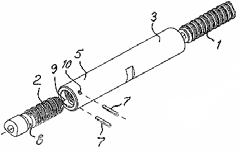Details:
Ex parte Kanflod
Appeal 2012005389; Appl. No. 10/539,148; Tech. Center 3600
Decided August 14, 2012
The application on appeal related to drilling machines. The independent claim on appeal was directed to a sleeve that couples a rock bolt (1) to a rock drilling machine (2). (See figure below.)
The limitation at issue read:
a locking device (7) ... said locking device is loaded to retain the rock drilling machine connected to the coupling sleeve only when said rock bolt is disconnected from said coupling sleeve by rotation of said rock drilling machine in a direction for disconnecting said first part of said coupling sleeve from said rock bolt for reinforcing a rock with said rock bolt.
(Emphasis added.)
During prosecution, the Applicant added the qualifier "only" in response to a prior art rejection. The Examiner then rejected the amended claim under § 112 First ¶, as lacking written description. The Office Action explained the problem with the phrase "only when ... disconnected" as follows:
[T]here is no structure to prevent the loading of locking device (7) to retain the rock drilling machine (2) connected to the coupling sleeve (3, 5) regardless of whether or not rock bolt (I) is connected or disconnected, since rock bolt (I) has no contact with either of locking device (7) or drilling machine (2) (even when the bolt is installed) and thus cannot prevent relative loading between device (7) and machine (2).
(Emphasis added.)
The Applicant submitted an expert declaration from the inventor to address the written description rejection. The declaration also explained the meaning of the limitation at issue. Referring to this declaration, the Applicant argued that the "only when ... disconnected" phrase should be read in conjunction with the "rotation" phrase:
[T]he locking device is loaded (locked) to lock the drilling machine to the coupling sleeve only when the drilling device is rotated in a direction to separate the rock bolt from the coupling sleeve, and not during a percussion operation.
The declaration, and the argument, then went on to reference portions of the specification that described this loading behavior in conjunction with the rotating.
The Applicant went to appeal on the written description, indefiniteness, and prior art rejection, with both sides essentially repeating the above written description arguments.
The Board found that the written description rejection was based on an improper claim interpretation, one which read the first portion of the wherein clause in isolation from the remainder of the claim.
A person skilled in the art would understand the above limitation to mean that the locking device is loaded just prior to disconnection of the rock bolt from the sleeve, i.e., when the rock bolt is still connected to the coupling sleeve. The Examiner improperly interprets the limitation to mean that the locking device is loaded only after disconnection of the rock bolt from the sleeve.
The Board reversed the written description rejection, finding that the Applicant's specification did convey possession of the properly interpreted claim.
The specification as originally filed explains that (1) during drilling the locking device 7 is unloaded (Spec. at 2:13-14) and (2) after drilling the locking device is loaded to disconnect the rock bolt from the coupling sleeve (Spec. at 2:14-19).
My two cents: Once again, the real issue is claim construction. It seemed to me that both sides recognized this, but could have done a better of job of explaining exactly how they were interpreting the claim. I had to keep reading the claim, and the arguments, over and over again.
The Examiner apparently read "disconnected" as referring to the bolt's final state, so that the phrase "only when" was interpreted to exclude loading with the bolt disconnected. On the other hand, the Applicant apparently read "only when ... disconnected" to refer to the action of disconnecting the bolt, or perhaps the bolt's intermediate state of being disconnected.
The choice of tense in "when disconnected" definitely sounds like a state rather than an action. It's only when the "by rotation" portion of the claim is considered that it even becomes possible to understand "disconnected" as an action. Still, I think the phrasing "only when said rock bolt is being disconnected" does a better job of conveying the Applicant's apparent intent.
My sense is that the issue of what tense to use comes up more in mechanical cases where you focus on describing structure first, and then on associating actions and states with the structure. Whereas action and state are more central to the claims I deal with every day in computer and electronics applications. Even so, I can think of instances where I've had to think about how to properly convey state, action, or a combination of the two – and it can be a challenge.

"A person skilled in the art would understand the above limitation to mean..."
ReplyDeleteReally? At what point did the BPAI take the time to explicitly determine the level of ordinary skill in the art so as to enable any reviewing body sufficient evidence to determine the accuracy of the BPAI's interpretation?
Why not just amend the claim to make it clear? It's much faster and much cheaper.
ReplyDeleteI can't understand how the claim can be read to exclude loading *after* disconnection. To me, the claim clearly excludes loading *before* disconnection. Whether it is in the process of being disconnected or already has been disconnected is not clear.
ReplyDelete